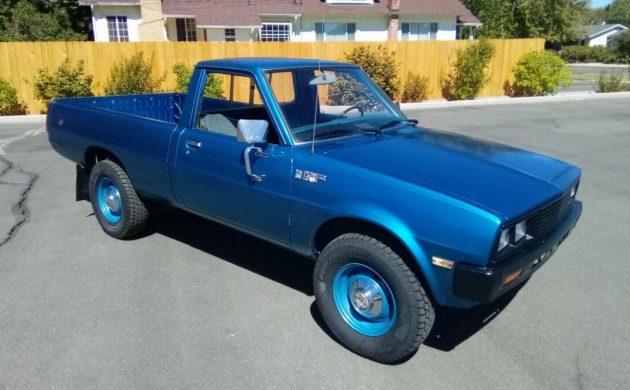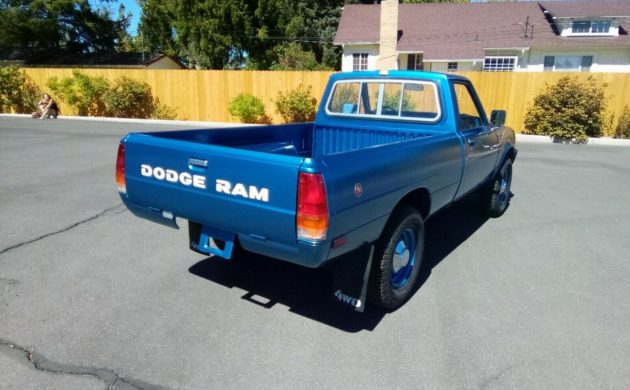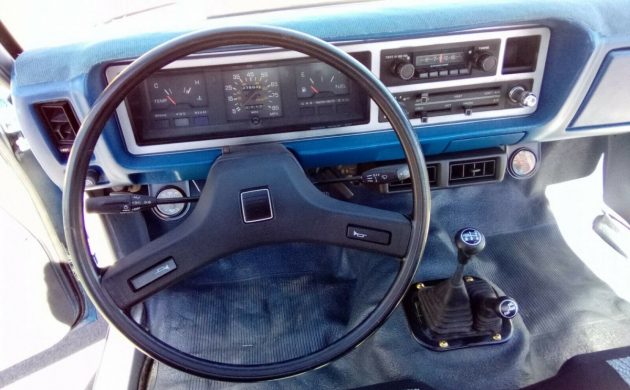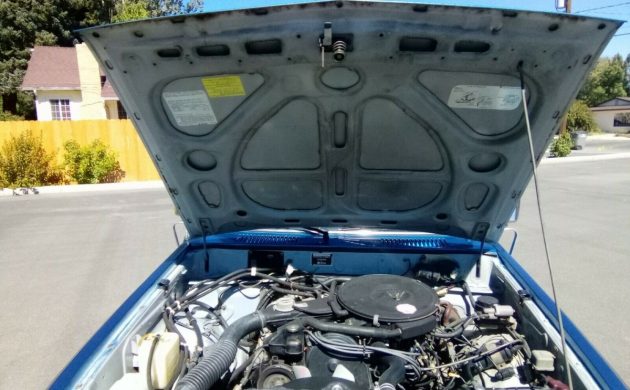When we see the re-badged Mitsubishi pickup that was known as the Dodge Ram 50 here in the states, it’s oftentimes the two-wheel drive, a long bed-style variety that is a great little hauler for the potting soil and pansies run made in the springtime. That’s not to belittle it; it’s a great option for light-duty jobs where you don’t want to mess up the interior of your daily driver. But an off-road or even just rough-road cruiser it is not; that’s where the rarely seen four-wheel-drive pickup comes in. This 1983 Dodge Ram 50 is one such vehicle, immediately recognizable by its slightly higher ride height. The seller reports this example has been in California most of its life and remains very solid and rust-free underneath. Find it here on eBay with bids to $2,275 and no reserve.
I’ve always liked these trucks, and our own Scotty G. has one in his project vehicle fleet. Most hardcore truck owners likely scoffed at these pint-sized haulers when new, but as we’ve seen lately, there’s a deep appreciation for a four-wheel-drive pickup that isn’t the size of a bus. The resurgence of the Ford Ranger and other small-to-mid-sized trucks is a testament to this, and it was the import brands that really blazed a trail for a smaller truck with four-wheel drive to become a reality (and the big domestic brands helped, too, by making trucks like these mainstream). The Dodge seen here does appear to have excellent cosmetics, right down to the original lettering on the tailgate still being visible.
The interior is equally immaculate, with a clean rubber floor liner, original gear shift knob, and original radio controls as well. The steering wheel shows no signs of visible flaws from grubby hands or prolonged sun exposure, nor does the dash. These trucks, despite their usefulness, were never exactly treated well by their owners (most trucks aren’t), as it was bought to be a workhorse that could get decent miles per gallon. Whoever owned this Dodge Ram 50 clearly put long-term use on their list of priorities, as it clearly never became a used-up workhorse. However, the heater fan and the radio are currently inoperable.
Despite looking like a survivor from the outside, there are some tell-tale signs that all is not as it seems. First, there’s the white paint inside the engine bay and under the hood, which suggests a respray and would make sense given how clean the exterior looks. Also, despite looking like a total sweetie, this Ram 50 has some running issues, with the seller noting that it needs a new carburetor, and that’s on the replacement that was previously swapped in. Still, it maintains good oil pressure and runs cool, so it has that going for it. It also supposedly has a new timing belt, so for the current bid amount and no reserve, it seems like a worthy gamble even with the mysterious paint job and defective carb.






These were made by Mitsubishi, and the Plymouth counterpart was called the Arrow. These used to be quite common here locally, but I haven’t seen one in years. It’s a shame that trucks this size are not being made anymore, as all the pickups, even the “small” ones, are oversized four-seaters that are rarely being used as trucks.
I recall Dominos Pizza in my area had a fleet of them. A person I worked with maintain them and said they were very reliable. We know what Delivery people do to vehicles.
Trucks this size are being made again. Check out the 2022 Ford Maverick. Starts at around $20k for the FWD Hybrid that gets close to 40 MPG
The New Maverick is a front wheel drive , 4 door short bed truck . Pretty useless for being a truck
No, the Maverick comes in 4WD as well. It has a payload capacity of 1500lbs, can carry 4×8 sheets, and can tow up to 4000 lbs so it’s a useful truck. Definitely more of a truck than this Dodge 50 actually. And a new base full sized Ram only has a payload of 1200 lbs so you might say its more of a truck than some full sized trucks.
The new Maverick is nowhere near this small, according to dimensions from Wikipedia:
1983 Dodge Ram 50 4×4:
Wheelbase 110 in (2,790 mm)
Length 184.6 in (4,690 mm)
Height 65 in (1,645 mm)
Width 65.0 in (1,650 mm)
2022 Maverick:
Wheelbase 121.1 in (3,076 mm)
Length 199.7 in (5,072 mm)
Height 68.7 in (1,745 mm)
Width 72.6 in (1,844 mm)
For comparison, the ’70s full-size Chevy squarebody:
Wheelbase 117.5 in (2,984 mm)
Length 191.5 in (4,864 mm)
Height 69.8 in (1,773 mm)
You left out the width of a square body which is 6″wider than a Maverick. Length of a standard sq body is also 6″ longer, you are quoting the short wheel base model. Height is about 3″ taller than a Maverick. So a Sq Body is bigger in every dimension. Wheelbase doesn’t factor into exterior size. The point is that the Maverick is about the size of the last Ranger, which is about the size of the 80’s mini trucks like this Dodge. All considered the small or mini truck class when compared with other trucks on the market at that time.
Ford is coming out with a small p/u called the Maverick and it’s suppose to be the same size as the old Ford Ranger, production started this past August.
Let’s see, if we’re charitably assuming they mean compared to the last-gen extended-cab old Ranger:
2022 Maverick:
Wheelbase 121.1 in (3,076 mm)
Length 199.7 in (5,072 mm)
Width 72.6 in (1,844 mm)
Height 68.7 in (1,745 mm)
’97-11 3rd-gen Ranger extended cab:
Wheelbase 117.6 in (2,987 mm)
Length 200.5 in (5,093 mm)
Width 70.3 in (1,786 mm)
Height 68.3 in (1,735 mm)
…so sure, but nowhere near as small as, say, the OG Ranger w/ standard bed/cab:
Wheelbase 107.9 in (2,741 mm)
Length 175.6 in (4,460 mm)
Width 66.9 in (1,699 mm)
I’ve got a second-gen version of these, basically just an updated body/interior on the same underlying chassis and mechanicals; it’s a nice-driving and capable little pickup.
Even today’s “midsize” trucks are about the same size or larger than a ’70s full-size Chevy C/K squarebody, nowhere near as small as the original midsize Dodge Dakota and Jeep Comanche, nevermind any compact pickups of yore like these.
Small pickups and utes are still being made, just not sold in the US anymore because of our absurd CAFE regulatory scheme:
https://www.thetruthaboutcars.com/2012/10/how-cafe-killed-compact-trucks-and-station-wagons/
The other thing that killed them was that the
companies could build a full-sized truck for not much
more money,but make a larger profit.
I was just reading about Ford’s new Maverick
pickup.It will be front wheel/all wheel drive,with a
giant 4.5 foot bed.No thanks.
Yep, Ford dropped the ball on this one – all we need is another 4 door toy with a bed big enough for a bag of grass seed. Can you imagine how many small trucks they could have sold if they actually built them like the old compact Rangers ?
I’ve been beating up a truck with a 5 ft bed for over a decade now and it’s all you need 95% of the time. I’d rather have the full sized rear seats than the bed space. Most people agree because that’s what people buy, not single cab rangers with huge beds
I have been looking for a small to midsized truck with an 8 foot bed for a while, can’t find one. I had one once, a 1992 Dakota, but I made the mistake of selling it.
There is no way I am going to fit in the cab of this cute little truck, & I lost 95 pounds in the last year.
As for the carburetor acting up, I’d infer from the snakes’ nest of vacuum hoses underhood it’s still got a stock-type Mikuni feedback-enhanced carb, which get notoriously finicky when old and aren’t at all easy to rebuild.
The preferred solution is to swap in a Weber 32/36 fed by a low-pressure electric fuel pump, which is pretty straightforward, eliminates most of the vacuum hoses and electric gizmos underhood, and an improvement in every way: better performance, reliability, economy, and emissions.
Just take care to get a genuine made-in-Spain Weber, avoiding the Chinese clones that only licensed the Weber name/logo and general design but aren’t finished to the same tolerances and thus can’t be properly tuned to run right in all conditions.
Have a 83 Mitsubishi mighty max 2 wheel drive.
Love it! Low mileage ( less then 70,0000) .
Replaced my Mikuni with a weber. My is only 2 liters,
but it was rated at 92 hp in 1983. That was a LOT for that
sized engine at the time. I had a brand new 1983 Ranger
2.3, and it only put out 80 hp.
I had a new ’85 D-50 base 2 wd model. It was a really good truck, and felt relatively fast. It was well used, from carrying dirt, to firewood. It also had six lug wheels, which I found surprising. My mistake was not buying a used, blue ’86 4X4, like this one, about 1988, or ’89. It was at a local VW dealership, of all places, and had only 19K on it. Asking price? $2900.00.
I had a Turbo Diesel ’83 Ram 50 and it was a real performer. Unfortunately I used it to pull a small fifth wheel trailer (which it would do even in 5th gear) and i took out the transmission not once but twice. That was when I decided I needed something bigger!
I had a Ram 50 4×4. Used it to tow a 48 Ford sedan from Bemidji Minnesota to Rhinelander Wisconsin. The trailer was homemade with no brakes. That Ford was so heavy that the trailer bed was sagging noticeably at both ends. Coming down the hill into Duluth I thought I would wet my pants. Very steep with a curve at the bottom. Did make it home without a problem. Probably near the top of the list of stupid things I did with cars.
Located in:
Yerington, Nevada
My buddies uncle has a earlier two wheel drive one of them. He also has a 13,000 mile 67 Hemi 4spd Belvedere. He transplanted a 340 4spd into it. Had a 8 3/4, factory hi Po exhaust manifolds, dual exhaust to the rear bumper, chrome tips etc. He was so obsessed with it he even added the pentastar to the lower right front fender. Beautiful little truck
That’s a beauty, Jeff! I believe, and I could be wrong, that engine is the 2.0L inline-four as opposed to the 2.6L. Bucket seats, a 5-speed, and some extra gauges would be involved if it were a higher trim level such as a Sport. My 1980 D-50 Sport had the Weber conversion before I got it a few years ago and it seems to have more than enough power for a small truck at somewhere over 100 hp. I’m thinking of doing an EFI conversion because it sits for weeks at a time and it’s a pain to pour gas in the carb every time I want to drive it. Or… maybe a new fuel pump first to see if that helps. One thing I don’t like is that cheesy tiny rectangular Weber air cleaner compared to the original factory look. There must be a way to modify an original air cleaner housing to fit the Weber.
The Redline Weber air cleaner adapter for a Toyota 20R engine works well enough with the stock airbox.
As for priming the gas, an electric fuel pump will let you run the pump before you start the engine. Ideally you’d have a relay powering the pump direct from the battery, with the trigger wire running through an oil-pressure switch for safety (to avoid hosing down the scene of a crash with raw fuel), but you could add another wire to trigger the relay manually with a switch. Or just rig the relay to run whenever the key is on, which isn’t as safe but would let you turn the key on for a few seconds before starting to prime the fuel feed.
And yeah, this looks like the 2.0L engine with a timing belt, rather than the 2.6 with timing chains.
Speaking of, I’m not sure if the airbox on these is similar to my ’87 2.6L, so if it’s got a smaller opening to the carb, a Suzuki Samurai airbox adapter might fit that better than the 20R adapter mentioned in my other comment.
Always regretted selling my 85′ 2.6l 4cyl. SPX 4X4 Mitsubishi. It’s rolling around a Pot farm in Santa Cruz since I sold it @2016. Loved that truck just had to sell it at the time. Got a Toyota Tacoma 2004 TRD 4×4 and it just wasn’t the same. Sold that too. No regrets.
Ended:
Oct 04, 2021
Winning bid:
US $4,450.00
[ 33 bids ]
I bought a Ram 50 4×4 Prospector Turbo Diesel new in ’83. It was the coolest truck. I’m not going to lie, I took care of it, but I was also hard as hell on it. The transfer case got a little loose from hard shifting in 2WD Low range (front hubs unlocked) The transmission shops didn’t know how to fix it. I sold it with around 60K miles to a local who did make the repairs and drove over the 200K mark before it finally was too rusty to save.